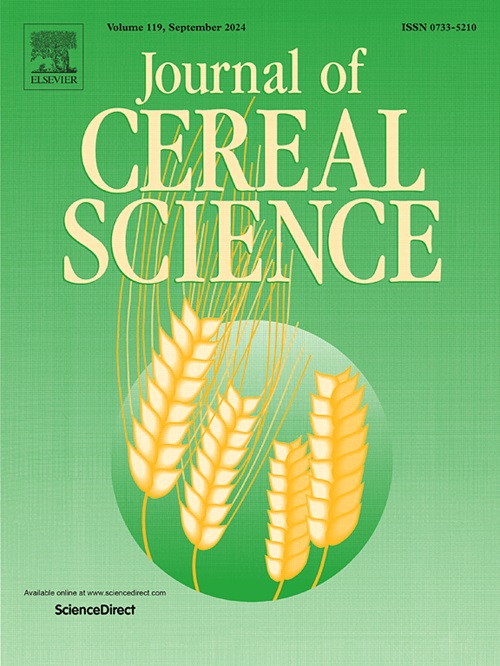Australian wheat cultivar gluten/gliadin sensitivity illustrates potential for celiac-safe wheat
IF 3.9
2区 农林科学
Q2 FOOD SCIENCE & TECHNOLOGY
引用次数: 0
Abstract
Wheat and wheat products are very popular in the general population. However, incidents of non-celiac gluten sensitivity (NCGS), gluten ataxia, neuro-psychiatric disorders wheat allergy and coeliac disease are observed to be on the increase. 11 varieties of wheat were assessed for gliadin and glutenin content and protein composition via SE-HPLC, RP-HPLC, Maldi-TOF, fructans and in vitro assays for assessing the efficacy of available cultivar fractions. Out of the 47–69 gliadin proteins, all 11 cultivars displayed 5 gliadin proteins and 43 polypeptides in one cultivar. Glutenin content was found to be 42–46% for all cultivars except one.
Cytotoxicity assays in CaCo2 cells demonstrated correlations between gliadin composition and cellular toxicity, with average levels of cytotoxicity for gliadin and glutenin at 10.7% and 16.3% respectively. α-gliadin showing the strongest link to increased cytotoxicity (Cultivars with lower gliadin content exhibited reduced cytotoxicity, highlighting their potential in breeding programs).
The findings underscore the feasibility of selecting wheat varieties with significantly lower toxic components while maintaining functional properties. Although modern breeding practices have not eliminated CD epitopes, they present opportunities to develop cultivars with minimized antigenicity. Future studies should expand cytotoxicity analyses using multiple cell lines or human organoids to deepen understanding and enhance breeding strategies. These insights can guide the production of safer wheat varieties for sensitive populations and inform sustainable agricultural practices.

澳大利亚小麦品种麸质/麦胶蛋白敏感性说明了乳糜泻安全小麦的潜力
小麦和小麦制品在普通人群中很受欢迎。然而,非乳糜泻麸质敏感性(NCGS)、麸质共济失调、神经精神疾病、小麦过敏和乳糜泻的发生率也在增加。采用SE-HPLC、RP-HPLC、Maldi-TOF、果聚糖等方法对11个小麦品种的麦胶蛋白和谷蛋白含量及蛋白质组成进行了测定,并对各品种有效组分的体外药效进行了评价。在47 ~ 69种麦胶蛋白中,11个品种均含有5种麦胶蛋白和43种多肽。除1个品种外,其余品种谷蛋白含量均为42 ~ 46%。cco2细胞的细胞毒性试验表明,麦胶蛋白成分与细胞毒性之间存在相关性,麦胶蛋白和谷蛋白的平均细胞毒性水平分别为10.7%和16.3%。α-麦胶蛋白与细胞毒性增加的关系最强(麦胶蛋白含量较低的品种细胞毒性降低,突出了它们在育种计划中的潜力)。这些发现强调了在保持功能特性的同时选择毒性成分显著降低的小麦品种的可行性。虽然现代育种实践并没有消除CD表位,但它们提供了开发具有最小抗原性的品种的机会。未来的研究应扩大使用多细胞系或人类类器官的细胞毒性分析,以加深理解和提高育种策略。这些见解可以指导为敏感人群生产更安全的小麦品种,并为可持续农业实践提供信息。
本文章由计算机程序翻译,如有差异,请以英文原文为准。
求助全文
约1分钟内获得全文
求助全文
来源期刊

Journal of Cereal Science
工程技术-食品科技
CiteScore
7.80
自引率
2.60%
发文量
163
审稿时长
38 days
期刊介绍:
The Journal of Cereal Science was established in 1983 to provide an International forum for the publication of original research papers of high standing covering all aspects of cereal science related to the functional and nutritional quality of cereal grains (true cereals - members of the Poaceae family and starchy pseudocereals - members of the Amaranthaceae, Chenopodiaceae and Polygonaceae families) and their products, in relation to the cereals used. The journal also publishes concise and critical review articles appraising the status and future directions of specific areas of cereal science and short communications that present news of important advances in research. The journal aims at topicality and at providing comprehensive coverage of progress in the field.
 求助内容:
求助内容: 应助结果提醒方式:
应助结果提醒方式:


